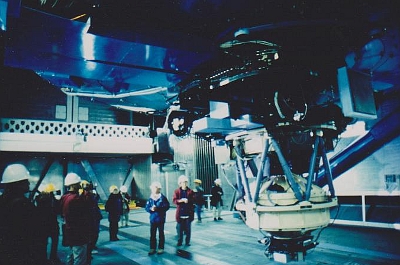December 31, 2010
Eleven years have already passed since the day when three
staff members of Geisei Observatory traveled to the summit of Mauna Kea
at night. They joined a tour group organized by OAA (Oriental Astronomical
Association) to visit the Subaru Telescope. It was in August and the middle
of summer heat, but the temperature at the 4200-meter-high summit was about
freezingly cold one degree Celsius. We persevered for about 30 minutes,
but the cold sent us back into the car after a hasty astrophotography session.
I don't know how they learned about my visit to Mauna Kea, but three American
astronomers who were observing at Mauna Kea came to see me at the Onizuka
Center.

The Subaru Telescope and its dome
The air inside the Subaru Telescope dome was air-conditioned
to night-time temperatures. It was like being inside an extraordinarily
large building and the 8-meter telescope was so large that its immense
size did not sink in immediately.

The summer Milky Way
At the nightfall the Milky Way above the observatory began
shining. I attempted a fixed tripod photo with a 35mm camera. Scorpius
and Sagittarius were shining brightly surprisingly high up in the sky.
It took me some time to identify the other constellations because of the
difference in latitudes.
This is the view toward the northwest from near the summit.
The Subaru dome is seen near the left edge of the photo. The mountain in
the distance is the volcano Heleakala. The stars were bright and appeared
as large as seen in paintings. The stars so low as hugging the horizon
were almost as bright as the stars seen at the zenith from Geisei. The
Big Dipper in Ursa Major loomed large. I thought, if I was able to observe
overnight, I would be able to make a discovery. I realized that the ancient
people always saw the stars like this on the ground and gradually formed
their own idea of the universe. It was the development of pre-Galilean
astronomy.



